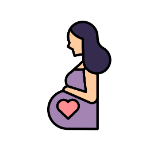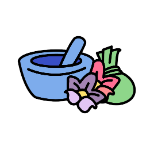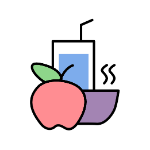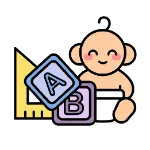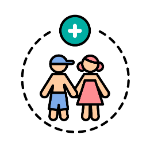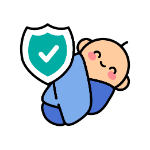
Feeding Guide
Age-By-Age Feeding Guide To Feed Your Baby For The First Year
5 min | Updated on 25-02-2022 by HappyPreggie
Are you having doubts about whether you're giving your kid enough breast milk, formula, or solid food? We've broken down some suggested quantities, but bear in mind that each infant's needs vary based on body weight, hunger, and age.

(Image credits to Canva)
Find out what and how much to feed your baby in the first year with our baby feeding guide. Don't worry if your child consumes a little more or less than the amounts indicated; they're only guidelines. Before beginning solids, it's usually a good idea to talk to your child's doctor about your plans.
Breast milk or formula should provide 100% of the calories for newborns. Here's an approximate summary.
Breast Milk. For the first two to four weeks, newborns prefer to eat on demand, generally 8 to 12 times in a 24 hour period (1 to 3 ounces per feeding). Keep an eye out for signs of hunger in your babies, such as increased alertness or activity, spouting, rooting, or suckling.

(Image credits to Canva)
Most nursing sessions last 20 to 45 minutes during the newborn period. Because newborns are often asleep, this amount of time may need patience and perseverance. Feed your baby on the first side until she stops sucking, her hands are no longer fisted, and she seems tired and relaxed.
Formula. A formula-fed baby will eat every three to four hours and will consume roughly 2 to 3 ounces every meal. As your child develops, this amount will rise. As a general guideline, give your infant 2.5 ounces of formula per pound of bodyweight every day.
Baby feeding chart age-by-age:

Your baby's appetite will rise between 1 and 3 months of age, and they'll become more vocal about expressing you when they're hungry—especially because they're probably on a regular feeding schedule by this time. A 2 months old baby will usually eat 3 to 4 ounces in per feeding, 6 to 8 times a day. If you're using a formula, search for one that has 2'-FL HMO as a supplement. The prebiotic is present naturally in breast milk and helps to maintain intestinal health.
Around 5 or 6 months of age, most babies are ready to begin solids. Mastering the gripping skill, acquiring head and neck control, and losing the tongue-thrust mechanism that reflexively pushes food out of their mouth are all signs that they're ready. Never begin solids before the age of four months.
Breast milk or formula should still provide almost all of a baby's calories when they are 6 to 9 months old. Aim for no more than 32 ounces of formula each day for Baby. They should consume anything from 6 to 8 ounces at each feeding and around 6 times a day when feeding.

(Image credits to Canva)
Don't worry about teaching babies to take solid food because they're still getting most of their calories from fluids. Feed up to two meals each day, with 2 to 4 tablespoons every meal. Serve iron-fortified single-grain baby cereal, as well as pureed vegetables, fruits, and meats. Start giving them finger meals such strained veggies, fruit, yogurt, cottage cheese, and casseroles about this time.
At this age, kids should drink 7–8 ounces of liquid every meal. In a 24-hour period, they normally consume 32 ounces of formula. Around half of your baby's calories should come from food by 9 to 12 months, with the other half coming from breast milk or formula.
Growing babies have an exploratory palate since they've learned that eating feels good, so don't be scared to give them chopped-up bites from your plate. If they want more, give it to them, but don't take it personally if they refuse. As babies like playing with their food, try dipping veggies or whole-grain crackers in yogurt or oatmeal. Simply cut or dice foods and avoid those that are small, round, hard, or the size of a child's airway.
We hope this article by HappyPreggie was informative for you. We know how hard the journey of motherhood is. That's why in HappyPreggie we try to ease your journey a bit with updated and informative articles.
While you read this article we would also suggest you read- How Can I Help My Baby With A Cold? or you might also like to read- How To Take Care Of Your Newborn's Umbilical Cord.
(Image credits to Canva)
Find out what and how much to feed your baby in the first year with our baby feeding guide. Don't worry if your child consumes a little more or less than the amounts indicated; they're only guidelines. Before beginning solids, it's usually a good idea to talk to your child's doctor about your plans.
Newborns
Breast milk or formula should provide 100% of the calories for newborns. Here's an approximate summary.
Breast Milk. For the first two to four weeks, newborns prefer to eat on demand, generally 8 to 12 times in a 24 hour period (1 to 3 ounces per feeding). Keep an eye out for signs of hunger in your babies, such as increased alertness or activity, spouting, rooting, or suckling.
(Image credits to Canva)
Most nursing sessions last 20 to 45 minutes during the newborn period. Because newborns are often asleep, this amount of time may need patience and perseverance. Feed your baby on the first side until she stops sucking, her hands are no longer fisted, and she seems tired and relaxed.
Formula. A formula-fed baby will eat every three to four hours and will consume roughly 2 to 3 ounces every meal. As your child develops, this amount will rise. As a general guideline, give your infant 2.5 ounces of formula per pound of bodyweight every day.
Baby feeding chart age-by-age:
Babies (1-3 Months Old)
Your baby's appetite will rise between 1 and 3 months of age, and they'll become more vocal about expressing you when they're hungry—especially because they're probably on a regular feeding schedule by this time. A 2 months old baby will usually eat 3 to 4 ounces in per feeding, 6 to 8 times a day. If you're using a formula, search for one that has 2'-FL HMO as a supplement. The prebiotic is present naturally in breast milk and helps to maintain intestinal health.
Babies (4-6 Months Old)
Around 5 or 6 months of age, most babies are ready to begin solids. Mastering the gripping skill, acquiring head and neck control, and losing the tongue-thrust mechanism that reflexively pushes food out of their mouth are all signs that they're ready. Never begin solids before the age of four months.
Ideally, you should feed your baby 1-2 teaspoons of food twice a day. Solid food should not be substituted for milk as a primary source of nourishment. When newborns are 4 months old, they should still consume around 4-6 ounces every feeding. They can drink up to 8 ounces every 4 to 6 times once they reach the age of six months.
Babies (6-9 Months Old)
Breast milk or formula should still provide almost all of a baby's calories when they are 6 to 9 months old. Aim for no more than 32 ounces of formula each day for Baby. They should consume anything from 6 to 8 ounces at each feeding and around 6 times a day when feeding.
(Image credits to Canva)
Don't worry about teaching babies to take solid food because they're still getting most of their calories from fluids. Feed up to two meals each day, with 2 to 4 tablespoons every meal. Serve iron-fortified single-grain baby cereal, as well as pureed vegetables, fruits, and meats. Start giving them finger meals such strained veggies, fruit, yogurt, cottage cheese, and casseroles about this time.
Babies (9-12 Months Old)
At this age, kids should drink 7–8 ounces of liquid every meal. In a 24-hour period, they normally consume 32 ounces of formula. Around half of your baby's calories should come from food by 9 to 12 months, with the other half coming from breast milk or formula.
Growing babies have an exploratory palate since they've learned that eating feels good, so don't be scared to give them chopped-up bites from your plate. If they want more, give it to them, but don't take it personally if they refuse. As babies like playing with their food, try dipping veggies or whole-grain crackers in yogurt or oatmeal. Simply cut or dice foods and avoid those that are small, round, hard, or the size of a child's airway.
We hope this article by HappyPreggie was informative for you. We know how hard the journey of motherhood is. That's why in HappyPreggie we try to ease your journey a bit with updated and informative articles.
While you read this article we would also suggest you read- How Can I Help My Baby With A Cold? or you might also like to read- How To Take Care Of Your Newborn's Umbilical Cord.
Join the largest support network for family health and well-being. Ready to get started?
Get started
